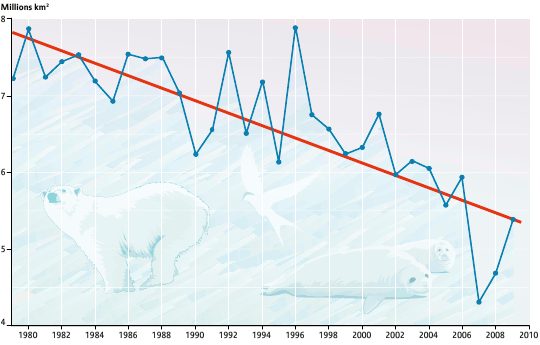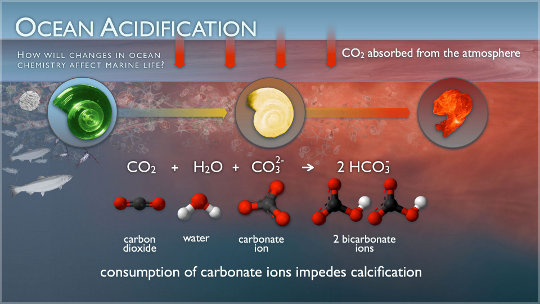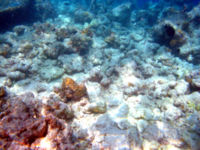The hyperlink between local weather change and biodiversity has lengthy been established. Though all through Earth’s historical past the local weather has all the time modified with ecosystems and species coming and going, speedy local weather change impacts ecosystems and species skill to adapt and so biodiversity loss will increase.
From a human perspective, the speedy local weather change and accelerating biodiversity loss dangers human safety (e.g. a significant change within the meals chain upon which we rely, water sources might change, recede or disappear, medicines and different assets we depend on could also be tougher to acquire because the vegetation and forna they’re derived from might cut back or disappear, and many others.).
The UN’s International Biodiversity Outlook 3, in Might 2010, summarized some issues that local weather change can have on ecosystems:
Local weather change is already having an influence on biodiversity, and is projected to develop into a progressively extra important menace within the coming a long time. Lack of Arctic sea ice threatens biodiversity throughout a complete biome and past. The associated stress of ocean acidification, ensuing from greater concentrations of carbon dioxide within the ambiance, can be already being noticed.
Ecosystems are already displaying unfavorable impacts underneath present ranges of local weather change … which is modest in comparison with future projected adjustments…. Along with warming temperatures, extra frequent excessive climate occasions and altering patterns of rainfall and drought might be anticipated to have important impacts on biodiversity.
Some species might profit from local weather change (together with, from a human perspective, an will increase in illnesses and pests) however the speedy nature of the change suggests that the majority species won’t discover it as useful as most won’t be able to adapt.
On this web page:
Local weather change impacts on biodiversity within the Arctic
The Arctic, Antarctic and excessive latitudes have had the best charges of warming, and this development is projected to proceed, because the above-mentioned International Biodiversity Outlook 3 notes (p. 56).
Within the Arctic, it isn’t only a discount within the extent of sea ice, however its thickness and age. Much less ice means much less reflective floor which means extra speedy melting. The speedy discount exceeds even scientific forecasts and is mentioned additional on this website’s local weather change introduction.
By way of biodiversity, the prospect of ice-free summers within the Arctic Ocean implies the lack of a complete biome
, the International Biodiversity Outlook notes (p. 57).
As well as, Complete species assemblages are tailored to life on prime of or underneath ice — from the algae that develop on the underside of multi-year ice, forming as much as 25% of the Arctic Ocean’s major manufacturing, to the invertebrates, birds, fish and marine mammals additional up the meals chain.
The enduring polar bear on the prime of that meals chain is due to this fact not the one species in danger though it might get extra media consideration.
Word, the ice within the Arctic does thaw and refreeze every year, however it’s that sample which has modified so much lately as proven by this graph:

Additionally it is essential to notice that lack of sea ice has implications on biodiversity past the Arctic, because the International Biodiversity Outlook report additionally summarizes:
- Brilliant white ice displays daylight.
- When it’s changed by darker water, the ocean and the air warmth a lot sooner, a suggestions that accelerates ice soften and heating of floor air inland, with resultant lack of tundra.
- Much less sea ice results in adjustments in seawater temperature and salinity, resulting in adjustments in major productiveness and species composition of plankton and fish, in addition to large-scale adjustments in ocean circulation, affecting biodiversity properly past the Arctic.
(This website’s intro to local weather change and Arctic geopolitics has extra in regards to the influence to the Arctic.)
Rising ocean acidification

Though it has gained much less mainstream media consideration, the results of accelerating greenhouse emissions — particularly carbon dioxide — on the oceans might be important.
Scientists have discovered that oceans are in a position to soak up among the extra CO2 launched by human exercise. This has helped preserve the planet cooler than it in any other case might have been had these gases remained within the ambiance.
Nonetheless, the extra extra CO2 being absorbed can be ensuing within the acidification of the oceans: When CO2 reacts with water it produces a weak acid known as carbonic acid, altering the ocean water chemistry. Because the International Biodiversity Outlook report explains, the water is a few 30% extra acidic than pre-industrial occasions, depleting carbonate ions — the constructing blocks for a lot of marine organisms.
As well as, concentrations of carbonate ions at the moment are decrease than at any time over the last 800,000 years. The impacts on ocean organic range and ecosystem functioning will possible be extreme, although the exact timing and distribution of those impacts are unsure.
(See p. 58 of the report.)
Though thousands and thousands of years in the past CO2 ranges had been greater, in the present day’s change is going on quickly, giving many marine organisms too little time to adapt. Some marine creatures are rising thinner shells or skeletons, for instance. A few of these creatures play a vital position within the meals chain, and in ecosystem biodiversity.
Some species might profit from the additional carbon dioxide, and some years in the past scientists and organizations, such because the European Challenge on OCean Acidification, shaped to attempt to perceive and assess the impacts additional.
One instance of current findings is a tiny sand grain-sized plankton liable for the sequestration of 25–50% of the carbon the oceans soak up is affected by growing ocean acidification. This tiny plankton performs a significant position in preserving atmospheric carbon dioxide (CO2) concentrations at a lot decrease ranges than they’d be in any other case so giant results on them could possibly be fairly severe.
Different associated issues reported by the Inter Press Service embody extra oceanic useless zones (areas the place there may be too little oxygen within the sea to help life) and the decline of essential coastal vegetation and forests, reminiscent of mangrove forests that play an essential position in carbon absorption. That is on prime of the already declining ocean biodiversity that has been occurring for a couple of a long time, now.
There may be additionally a linkage with local weather change:
Ocean stratification, the place heat water sits firmly on prime of chilly, nutrient-rich water, additionally creates useless zones and lowers the general productiveness of the oceans.… Such useless zones had been uncommon 40 years in the past however now quantity a number of hundred. With out pressing motion, local weather change will proceed to heat oceans, growing stratification and producing bigger and extra useless zones with a significant influence on future fisheries, a 2009 examine in Nature Geoscience warned.
It’ll take a thousand years for the oceans to chill down, so it’s crucial to tug the emergency brake on world warming emissions, the examine concluded.
Coral reefs threatened by local weather change
Around the globe, coral reefs have been dying largely resulting from local weather change.


Wholesome coral may be very colourful and wealthy with marine life.
At the start of September, 2009, the Australian company taking care of the Nice Barrier Reef launched an outlook report warning the Nice Barrier Reef is in hassle.
However it isn’t simply the Nice Barrier Reef in danger. All of them are in danger, says Charlie Veron, an Australian marine biologist who’s broadly considered the world’s foremost knowledgeable on coral reefs.
The longer term is horrific
, he says. There isn’t any hope of reefs surviving to even mid-century in any type that we now acknowledge. If, and when, they go, they’ll take with them about one-third of the world’s marine biodiversity. Then there’s a domino impact, as reefs fail so will different ecosystems. That is the trail of a mass extinction occasion, when most life, particularly tropical marine life, goes extinct.
Coral reefs present many ecosystem companies to people as properly, without cost. This website’s web page on coral reefs goes into these points in additional depth.
Lizards threatened by local weather change

What the BBC described as a global-scale examine
revealed within the journal Science discovered that local weather change might wipe out 20% of the world’s lizard species by 2080.
International projection fashions utilized by the scientists instructed that lizards have already crossed a threshold for extinctions brought on by local weather change
.
The concern of lowland species transferring to greater elevations has lengthy been predicted as an impact of local weather change. This has been noticed with lizard populations too, because the chief of the analysis staff instructed the BBC: We are literally seeing lowland species transferring upward in elevation, slowly driving upland species extinct, and if the upland species can’t evolve quick sufficient then they’re going to proceed to go extinct.
Why are lizards so delicate to local weather change? The BBC summarizes:
Lizards, the researchers say, are way more inclined to climate-warming extinction than beforehand thought. Many species stay proper on the fringe of their
thermal limits.Rising temperatures, they defined, go away lizards unable to spend enough time foraging for meals, as they need to relaxation and regulate their physique temperature.
Different examples
The above areas of biodiversity affected is not at all exhaustive. Different areas affected by local weather change embody terrestrial animals, and forests, water sources and associated ecologies, and so forth. For extra data on these areas, see this website’s sections on

